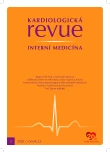Continuous anticoagulant therapy in catheter ablation of atrial fibrillation
Authors:
Lábrová R.; Lábr K.
Authors‘ workplace:
I. interní kardioangiologická klinika LF MU a FN u sv. Anny v Brně
Published in:
Kardiol Rev Int Med 2020, 22(2): 63-68
Overview
Catheter ablation of atrial fibrillation is indicated in symptomatic patients in whom antiarrhythmic therapy usually fails. The risk of thromboembolism in patients with atrial fibrillation is stratified according to the CHA2DS2-VASc score and anticoagulant therapy is used, either a vitamin K antagonist – warfarin, or direct anticoagulants – dabigatran, rivaroxaban, apixaban, edoxaban. Patients undergoing ablation have an increased risk of bleeding, but also a higher risk of thromboembolic events. The COMPARE study showed that continued warfarin treatment reduced bleeding and thromboembolic complications in atrial fibrillation ablation. Subsequent randomised studies with direct anticoagulants – the VENTURE AF study with rivaroxaban, the RE-CIRCUIT study with dabigatran, AXAFA-AFNET 5 with apixaban and the last published ELIMINATE AF study with edoxaban gave the same results. Thus, bridging with low molecular weight heparin is not indicated in catheter ablation of atrial fibrillation, as it involves more bleeding and thromboembolic complications. This also applies to implantations of pacemakers and defibrillators.
Keywords:
stroke – bleeding – atrial fibrillation – catheter ablation – uninterrupted anticoagulation
Sources
1. Čihák R, Haman L, Táborský M. Doporučené postupy ESC 2016 pro léčbu fibrilace síní formulované ve spolupráci s EACTS. Souhrn dokumentu připravený Českou kardiologickou společností. Cor Vasa 2016; 58(6): 728–771. doi: 10.1016/ j.crvasa.2015.09.005.
2. Kirchhof P, Benussi S, Kotecha D et al. 2016 ESC Guidelines for the management of atrial fibrillation developed in collaboration with EACTS. Eur Heart J 2016; 37(38): 2893–2962. doi: 10.1093/ eurheartj/ ehw210.
3. Steffel J, Verhamme P, Potpara TS et al. The 2018 European Heart Rhythm Association Practical. Guide on the use of non-vitamin K antagonist oral anticoagulants in patients with atrial fibrillation. Eur Heart J 2018; 39(16): 1330–1393. doi: 10.1093/ eurheartj/ ehy136.
4. Čihák R. Prevence trombembolických komplikací u pacientů s fibrilací síní. In: Varvařovský I, Branny M, Čihák R et al. Antitrombotika v kardiologii. Praha: Mladá fronta 2020.
5. Lábrová R, Špinar J. Antikoagulační terapie a fibrilace síní. Kardiol Rev 2012; 14(2): 79–86.
6. Špinar J, Lábrová R. Antikoagulační terapie u fibrilace síní. Remedia 2011; 21(2): 168–170.
7. Lábrová R, Špinar J. Katetrizační ablace fibrilace síní. Kardiol Rev 2008; 10(3): 103–110.
8. Di Biase L, Burkhardt JD, Santangeli P et al. Periprocedural stroke and bleeding complications in patients undergoing catheter ablation of atrial fibrillation with different anticoagulation management: results from the Role of Coumadin in Preventing Thromboembolism in Atrial Fibrillation (AF) Patients Undergoing Catheter Ablation (COMPARE) randomized trial. Circulation 2014; 129(25): 2638–2644. doi: 10.1161/ CIRCULATIONAHA.113.006426.
9. Cappato R, Marchlinski FE, Hohnloser SH et al. Uninterrupted rivaroxaban vs. uninterrupted vitamin K antagonists for catheter ablation in non-valvular atrial fibrillation. Eur Heart J 2015; 36(28): 1805–1811. doi: 10.1093/ eurheartj/ ehv177.
10. Calkins H, Willems S, Gerstenfeld EP et al. Uninterrupted dabigatran versus warfarin for ablation in atrial fibrillation. N Engl J Med 2017; 376(17): 1627–1636. doi: 10.1056/ NEJMoa1701005.
11. Špinar J, Lábrová R. Katetrizační ablace fibrilace síní a přímá antikoagulancia. Kardiol Rev Int Med 2017; 19(3): 183–186.
12. Kirchhof P, Haeusler KG, Blank B et al. Apixaban in patients at risk of stroke undergoing atrial fibrillation ablation. Eur Heart J 2018; 39(32): 2942–2955. doi: 10.1093/ eurheartj/ ehy176.
13. Hohnloser SH, Camm J, Cappato R et al. Uninterrupted edoxaban vs. vitamin K antagonists for ablation of atrial fibrillation: the ELIMINATE-AF trial. Eur Heart J 2019; 40(36): 3013–3021. doi: 10.1093/ eurheartj/ ehz190.
14. Lábrová R, Lábr K. Edoxaban – farmakologický profil. Kardiol Rev Int Med 2017; 19(1): 45–50.
15. Birnie DH, Healey JS, Wells GA et al. Continued vs. interrupted direct oral anticoagulants at the time of device surgery, in patients with moderate to high risk of arterial thrombo-embolic events (BRUISE CONTROL-2). Eur Heart J 2018; 39(44): 3973–3979. doi: 10.1093/ eurheartj/ ehy413.
16. Steinberg BA, Peterson ED, Kim S et al. Use and outcomes associated with bridging during anticoagulation interruptions in patients with atrial fibrillation findings from the Outcomes Registry for Better Informed Treatment of Atrial Fibrillation (ORBIT-AF). Circulation 2015; 131(5): 488–494. doi: 10.1161/ CIRCULATIONAHA.114.011777.
Labels
Paediatric cardiology Internal medicine Cardiac surgery CardiologyArticle was published in
Cardiology Review

2020 Issue 2
Most read in this issue
- Modified Valsalva manoeuvre in pre-hospital care – a case report
- Urapidil – an antihypertensive drug with a dual action mechanism
- Clinical experience in the use of the infusion fixed combination Neodolpasse (diclofenac/ orphenadrine) in the postoperative period in cardiac surgery patients
- Cardiovascular prevention news
